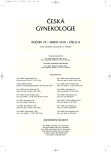Analysis of cell free fetal DNA fragmentation rate in pregnant women during the course of gravidit
Authors:
R. Vodička; J. Böhmová; I. Dhaifalah; J. Blumenthalová; R. Kratochvílová; J. Šantavý; M. Procházka; R. Vrtěl
Authors‘ workplace:
Ústav lékařské genetiky a fetální medicíny FN, Olomouc, přednosta prof. MUDr. J. Šantavý, Ph. D.
Published in:
Ceska Gynekol 2010; 75(4): 312-316
Overview
Aim of study:
To assess cell free fetal DNA (cffDNA) fragmentation rate in pregnant women during the course of gravidity.
Study design:
QF PCR efficiency in cffDNA and quantitative analyses in particular cffDNA molecular size fractions.
Setting:
The study was performed at Department of Medical Genetics and Fetal Medicine, University Hospital Olomouc.
Method:
1. 363 plasma DNA samples from women in different week of pregnancy (from 4th w.g. to 37th w.g.) were tested for QF PCR efficiency in particular STRs and AMELX/Y.
2. Size fractionated cff DNA (150–300 bp, 300–500 bp, 500–760 bp) was quantified by QF PCR in 91 pregnant women (from 9th w.g. to 40th w.g.).
3. Size fractionated cff DNA from male fetuses was quantified by real time PCR (SRY/internal control) in 22 pregnant women (from 9th w.g. to 36th w.g.).
Results:
1. QF PCR efficiency decreased from longer to shorter molecules.
2. The only 500 -760 bp fraction showed cffDNA increase in relation to week of gravidity.
3. Indirect relation between amount of cffDNA and week of gravidity was found in 150-300 bp fraction by Real-time PCR.
Conclusion:
Assembling of all 3 approaches indicates increase of longer cffDNA molecules during the gravidity while level of the short cffDNA molecule fragments probably remains from the approximately 9th w.g. the same.
Key words:
cell free fetal DNA, noninvasive prenatal diagnosis, DNA fragmentation rate, QF PCR, real time PCR.
Sources
1. Alberry, MS., Maddocks, DG., Hadi, MA., et al. Quantification of cell free fetal DNA in maternal plasma in normal pregnancies and pregnancies with placental dysfunction. Am J Obstet Gynecol 2009, 200(1), p. 98.e1-6.
2. Ariga, H., Ohto, H., Busch, MP., et al. Kinetics of fetal cellular and cell-free DNA in the maternal circulation during and after pregnancy: implications for noninvasive prenatal diagnosis. Transfusion Med 2001, 41, p. 524?1530.
3. Farina, A., Caramelli, E., Concu, M., et al. Testing normality of fetal DNA concentration in maternal plasma at 10-12 completed weeks‘ gestation: a preliminary approach to a new marker for genetic screening. Prenat Diagn 2002, 22, 2, p. 148-152.
4. Hahn, S., Holzgreve, W. Prenatal diagnosis using fetal cells and cell-free fetal DNA in maternal blood: what is currently feasible? Clin Obstet Gynecol, 2002, 45, 3, p. 649-656.
5. Honda, H., Miharu, N., Ohashi, Y., et al. Fetal gender determination in early pregnancy through qualitative and quantitative analysis of fetal DNA in maternal serum. Hum Genet 2002, 110, 1, p. 75-79.
6. Chan, KC., Zhang, J., Hui, AB., et al. Size distributions of maternal and fetal DNA in maternal plasma. Clin Chem 2004, 50, p. 88–92.
7. Koide, K., Sekizawa, A., Iwasaki, M., et al. Fragmentation of cell-free fetal DNA in plasma and urine of pregnant women. Prenat Diagn 2005, 25, p. 604–607.
8. Li, Y., Zimmermann, B., Rusterholz, C., et al. Size separation of circulatory DNA in maternal plasma permits ready detection of fetal DNA polymorphisms. Clin Chem 2004, 50, 6, p. 1002-1011.
9. Lo, YM., Tein, MSC., Lau, TK., et al. Quantitative analysis of fetal DNA in maternal plasma and serum: implications for noninvasive prenatal diagnosis. Am J Hum Genet 1998, 62, p. 768–777.
10. Vodicka, R., Vrtel, R., Dusek, L., et al. Refined fluorescent STR quantification of cell-free fetal DNA during pregnancy in physiological and Down syndrome fetuses. Prenat Diagn 2008, 28, 5, p. 425-433.
11. Vodička, R., Vrtěl, R., Schneiderová, E., a kol. Neinvazivní detekce gonozomálních DNA sekvencí v lazmě gravidních žen s yužitím kapilární elektroforézy. Čes Gynek 2008, 73, 3, s. 150-153.
12. Zhang, P., Ren, JC., Shen, ZJ. A novel method for quantification of circulating DNA in serum by capillary zone electrophoresis. Chin Chem Lett 2004, 15, 9, p. 091-1094.
13. Zhong, XY., Burk, MR., Troeger, C., et al. Fetal DNA in maternal plasma is elevated in pregnancies with aneuploid fetuses. Prenat Diagn 2000, 20, p. 795–798.
Labels
Paediatric gynaecology Gynaecology and obstetrics Reproduction medicineArticle was published in
Czech Gynaecology

2010 Issue 4
Most read in this issue
- Shoulder dystocia during vaginal delivery
- Repair of the 3rd and 4th degree obstetric perineal tear
- Perinatal brachial plexus palsy
- Complications of radical oncogynecological operations
